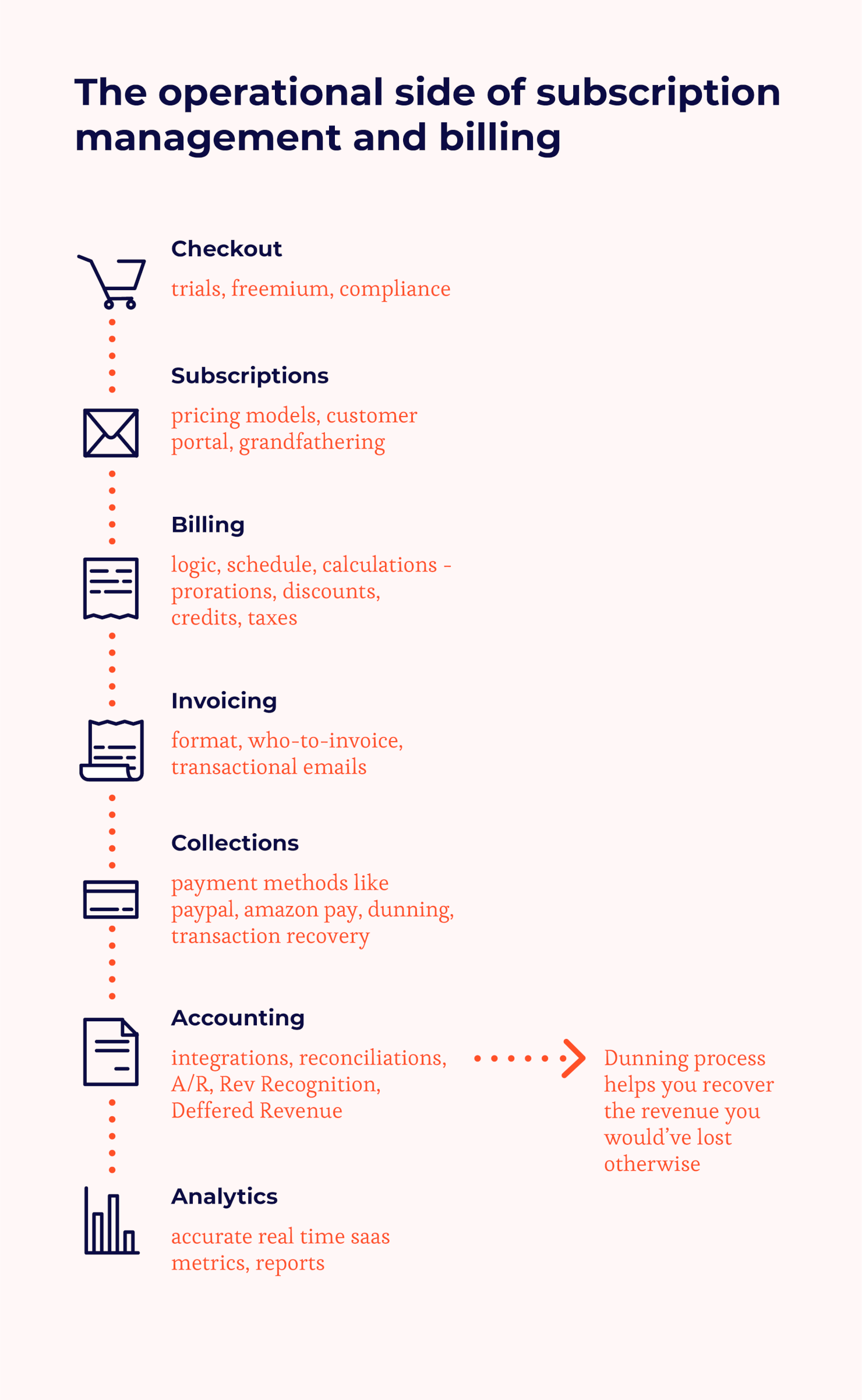Subscription services, from meal planning to coffee shops to distraction blockers, took off during the pandemic and have continued to enjoy tremendous success. Choosing ecommerce subscription management software can help with this—whether you’ve started to offer subscriptions or are still thinking about it.
While selecting an ecommerce subscription management software may seem easy now (some organizations even build their own!), it’s important to plan for the future. And, to future-proof your business, you’ve got to have a plan for growth.
The global ecommerce growth rate is forecast at 8.9% for 2023, bringing global ecommerce sales to $5.9 trillion. With so much growth in the ecommerce market, you need to make sure that you research thoroughly when selecting your ecommerce subscription management software.
After all, this is going to be a piece of your tech stack that makes one of the biggest impacts on your business—from finance to sales—and your revenue. As you’re considering what software suits your business now, it’s also important to consider what will suit your business in the future.
What is Subscription Billing and How Does it Differ from Other Billing?
Hold up a second. If you’re new to subscription billing, let’s go over a few key terms that might come up during our exploration of this new revenue stream.
Subscription billing is the process of billing customers on a recurring basis for their subscriptions (think of any subscription box service, like Birchbox or Blue Apron).
Ecommerce subscription management software helps you manage your entire subscription process—from your product catalog to your subscribers to your billing cycles.
A great subscription management software will be able to:
- Integrate with your existing tech stack or with tools you know and love (like Stripe or Salesforce)
- Streamline your revenue operations
- Give you ways to do all this (and more) without needing developers to maintain your codebase.
This leaves you free to focus on building those customer relationships, and your business, while your subscription management software gives you peace of mind by streamlining that operational side of things—as you can see in the chart below.

What are the benefits of Ecommerce Subscription Management Software?
Now that you’re ready to explore your options, let’s discuss some of the key points that will help you along your journey to joining the subscription side of ecommerce.
Many ecommerce management solutions highlight all of the features but not all of the benefits. However, it’s the benefits that matter the most to your business and make the biggest impact.
Automate recurring billing workflows
With any good ecommerce subscription management software, you’ll be able to automate your entire recurring billing process (we suggest doing this first if you haven’t set up recurring billing, but it’s never too late to start).
So, whichever solution you select, make sure that the automation of billing workflows is at the crux of the solution. Additionally, there should be implementation and migration specialists to make sure that the entire automation process is as painless as it can possibly be. Automation like this can lead to massive MRR improvements.
Additionally, with billing automation, your organization should be able to open new doors to things like pricing experiments, subscription flexibility, and better coupon or discount tracking and distribution.
Manual billing makes everything harder and leaves you with less room to experiment to find the perfect pricing formula for your customers.
Streamline your operations
While streamlining your billing is definitely a key consideration, your operations should be a close second. Above all else, streamlining your operations can help you reduce overall costs, saving you time and money and freeing up resources to pursue those ambitious growth goals you have.
Workflows that help automate departments outside of billing (such as sales) can help you reach a variety of customers at different places in the cycle without even thinking about it (once it’s set up, of course!).
With a common platform that can be used as a single source of truth for everyone, from billing to marketing, your new solution should be able to help you smooth out any bumps in the road or prevent them from even appearing.
Related Read: 10 Best Ecommerce Product Data Management Software
Compliance: from PCI to taxes
Compliance, whether for taxes or security, can be daunting. If you’re building your own software in-house to handle this, you’ll likely run into a high number of issues. But never fear: Selecting the right solution for your ecommerce subscription business can solve many of these problems.
Regarding taxes, with the right integrations, you can save yourself the time and effort of manual tax calculations. You can slot in and be ready to hit compliance as soon as possible. To take advantage of this, you’ll want to make sure that the solution and integration will get up-to-date information on sales taxes in any geography you’re selling in.
For any payment processing you’re doing (and we hope you’re doing a lot), you’ll need to be PCI DSS compliant—no matter your size, location, or even the number of transactions. Failure to comply with PCI DSS can lead to a hefty fine or, even worse in the age of online shopping, not being able to accept credit cards.
Key Considerations while Choosing a Subscription Management Software
You’re a future-focused leader and you’re thinking about growth. The right ecommerce subscription management system can give you so many benefits.
We’ve discussed how automating your process can not only streamline your operations but also integrate with your existing tech stack and help you grow your recurring revenue business.
Now let’s dive into some of the things you should consider and how they’ve helped our customers when assessing a subscription management solution:
1. Pricing—Pricing is obviously one of the first things you’ll think about when assessing a new piece of software. Many subscription management solutions come with a variety of pricing options (or tiers) that you can choose from. If you’re considering a free trial, there are some options out there, so it’s definitely something to take into account. Along with working with your pricing in one currency, you should also look for software that can work with multiple currencies. That way, when your organization grows and expands, you’re ready to go.
2. Scalability—Scaling is a (good) pain point we hear often. Hypergrowth is a phase many subscription-based businesses are in. If you want to take advantage of that growth, you need a solution that scales with you.
For example:
- If you plan to expand your geographical footprint, your subscription management tool should support multiple currencies, payment gateways, and take care of all the tax worries!
- If you’re looking to launch new product lines, or experiment with your pricing, your billing solution should have a scalable product catalog that helps you map add-ons, charges, currency, and billing frequency to each plan with ease and efficiency.
3. Mobility—According to design and ecommerce firm OuterBox, 79% of smartphone users have made a purchase online using their mobile device in the last 6 months. With that, you should be assessing the ability to use mobile checkout with your subscription service. Or, if you have a mobile app, you’ll want to ensure that the subscription service allows customers to manage their subscriptions on their phones. It is also important that the tool supports one-time as well as subscription checkout, so you get the best of both worlds!
4. Security—Security, for both you and your customers, is absolutely paramount. PCI DSS compliance is required to process branded credit cards from major credit card companies. That brings your consumers a sense of security as well as actual protection provided by services like a payment gateway, and multiple types of payment (Apple Pay, Amazon, ShopPay).
Build Versus Buy
When starting from scratch, you might be tempted to build out your own subscription management system. Perhaps you can pull resources from other parts of your business to create something brand new.
However, if you think about the risks, the manpower, the level of security, and the sheer number of departments that will have to be involved as your company grows—well, your in-house billing software has become an important part of your infrastructure.
Moreover, as you grow, things get more complicated. Selling internationally, or expanding your current geographic locations, means you need to ensure that you’re tax compliant and you’re offering products in the currency that makes sense for that region. And there’s always a security to think about, such as PCI DSS compliance. Plus, with the recent changes to accounting standards with ASC 606—the list goes on.
With an out-the-box ecommerce subscription management software, you can remove those things from your plate, letting singularly focused individuals help you deal with everything that could eventually (or is currently) muddying up your revenue story.
Now that you have enough and more reasons to opt for a subscription billing platform, this detailed guide on how to get started with a subscription billing system will be very useful to take things forward.
Want more essential advice for your ecommerce business? Subscribe to The Ecomm Manager newsletter today.
More great ECM content:
- What Is An Ecommerce Subscription Model: Examples, Setup & Top Platforms
- How To Start A Subscription Box: A Step-By-Step Guide For Ecommerce
- What Is A Payment Gateway & How Does It Work For Your Online Store?
- Ecommerce Credit Card Processing Guide: How To Set Up & Accept Cards
- 10 Best Subscription Management Software
- 10 Best Payment Gateway Providers
- 10 Best Payment Processing Software


